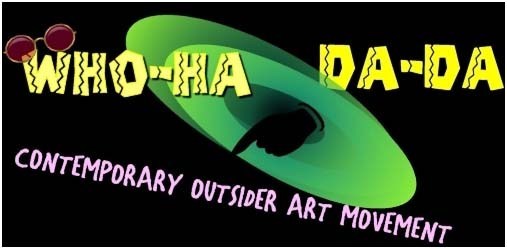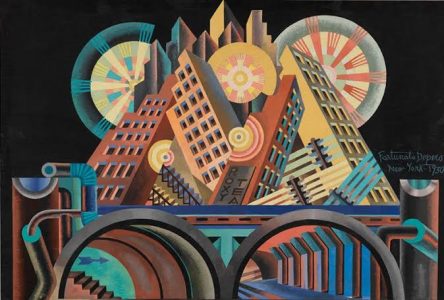Dadaism is an art direction that originated in Zurich, Switzerland in 1916, and emerges in response to the tragedy brought to humanity by World War I. A group of artists has launched Dada magazine, which represents the very beginnings of creation in this artistic direction.
Dadaism was born in the struggle against tradition and its artistic canons, against civil society and its criteria, to rename values, artistic and cultural, but also a political, social, scientific and technological process.
There is a view that the name derives from the French word “dada” which means “wooden horse” in translation.
This trend is based on new forms of expression, journals, subversive and alternative forms of artistic discourse.
One of the characteristic forms in artistic expression is collage, which is often used by Dadaists as a form that allows the best ideas of Dadaism, the idea of nothingness and the meaninglessness of all that exists. Dadaism advocates the destruction of traditional values, irony, paradox, grotesque, extolling urges and nihilistic practices, counting on causing shock in the audience. The artworks that Dadaism created are a representation of everyday objects that are presented in a completely astonishing way, which changes their original function and meaning of existence and gives them a new dimension while causing astonishment for the viewer.
Dada cannot identify with any person, point of view or style, nor has she ever acquired a unique, coherent program. Still, the most famous Dadaists are Jean Arp, Hugo Ball, Philippe Soupault, Andre Breton, Richard Huelsenbeck, Louis Aragon, etc. All of them had the common view that whatever culture, art, literature, politics, and the entire society had been propagating by then, was a great immoral and senseless idea of the world and the purpose of existence.
Thus, as an avant-garde movement, Dadaism offered a new worldview that enabled young people to criticize the existing order and show the revolt and rebellion they were entitled to. The best description of the basic idea and purpose of Dadaism is the words of its creator Cara:
“… Dada arose from a rebellion that was common to all young people of the rebellion at the time, which required individuals to accept the needs of their nature, regardless of history, to logic…”
Looking at the products of the First World War and all the forms that the war brought, the artist approaches his work with a morbid attitude. What was beautiful before then and art no longer holds. The artist has become an anti-artist, he has to make fun of it. Also, with its open and accentuated anti-bourgeois attitude, it enters the heart of the people and spreads throughout the major art centers of the twentieth century.
Existentialism
Modernism dates to the late nineteenth century and is divided into several literary directions: aestheticism, the avant-garde, late modernism, and postmodernism. As part of late modernism, this is how existentialism emerges, one of the most influential literary trends that emerged in the first half of the twentieth century.
Existentialism is a philosophical direction that deals with the problem of human existence, its shaky foundations since it emerged after the First World War. The essence of existentialism is to turn to the individual, the subjective, as opposed to the philosophy of the past, which cared about the general and the universal. The existentialist philosophy is based on the co-operation of the categories of essence and existence. The essence is what makes things different from each other. Existence is what shapes the essence and what precedes it: existence, reality, way of life. The essence is that which is the possibility of being, and different from existence and reality.
The most famous are representatives of existentialism Jean-Paul Sartre, the creator of the very name “existentialism”, and Albert Camus. It is important to note that the roots of the philosophy of existentialism are already hidden in the works of some nineteenth-century philosophers such as Soren Kierkegaard and Friedrich Nietzsche. In their work, these philosophers have discussed issues such as freedom, the value of human existence and its meaning, man’s relation to death and life…
Kierkegaard, according to many, the first philosopher of existentialism, thought that human existence is best manifested in moments when a person is dominated by strong feelings such as despair and anxiety or when a person is confronted with the problem of his freedom and free choice.
Camus is also considered the creator of literary absurdity, a direction closely linked to existentialism. The literature of the absurd, in particular, studies the behavior of the individual in situations that are seemingly meaningless or insignificant.
With changes in human society, man becomes more and more aware of his flaws and the shortcomings of the world around him. After two world wars and various economic and political crises and changes in the society that had already gripped the world by then, an individual is slowly losing hope for a better tomorrow. Representative works of each literary period outline the modern man of the time, and the works of existentialist writers are no different from their predecessors. In their works, they outlined their own, but also the fears of their fellow citizens. Their main characters are intellectuals, independent and even isolated individuals who are often at odds with society.
In addition to the philosophy of existentialism, which is the origin of the overall philosophy of everyday life, melancholy-colored chansons and poetry expressed in a slightly darker range, existentialists have introduced a special fashion trend, wide-flannel shirts, oversized black wool sweaters, slightly wider trousers or jeans, and big scarves.
The inability to communicate is twofold: on the one hand, a man, without accepting the social game under the mask, is doomed to loneliness, misunderstanding and the fate of a rejected stranger. On the other hand, a society blinded by conventions and the rigid, inhumane norms upon which it rests, sinks irreversibly into ruin.
In the end, the rebel man, a stranger in a world of absurdity and cold malice, only has to refuse boldly and consciously to reject the rules of the social game imposed on him and refuse a compromise settlement for the survival of the truth — the bare, existential, arrogant and essential needs of his being…
Dadaism Vs Existentialism
The basic common goal of these movements is to start, provoke and debate on various topics. It is in these epochs that old values are destroyed and new attitudes and styles are imposed. Many literary innovations and aesthetic research have taken place. The avant-garde was founded as a movement intended to liberate and discover. During this period, the boldest efforts were made to create as original art as possible.
These artistic trends encourage research and experimentation, although there was too much hyperbole and fabrication on the move, it was never exaggerated. In the avant-garde, absurd themes and motives develop, thus combating the ideological or existential nonsense of reality.
The most unconventional among the avant-garde movements is Dadaism. Dadaism is formed as a resistance to finished forms and linguistic clichés. This avant-garde direction fights for the immediacy of expression. He prefers spontaneous expression, basing his theory of art on contradictions. The historical significance of Dadaism and surrealism is that they draw attention to the problem of the institution of art, its infertility, and in particular “literature at the end of symbolism”. They think that, on the outside, objectively and formally, they are incapable of displaying the essence of man.

